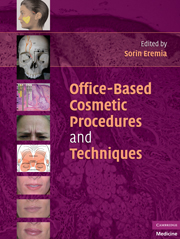Book contents
- Frontmatter
- Contents
- PREFACE
- CONTRIBUTORS
- PART ONE ANATOMY AND THE AGING PROCESS
- PART TWO ANESTHESIA AND SEDATION FOR OFFICE COSMETIC PROCEDURES
- PART THREE FILLERS AND NEUROTOXINS
- Chap. 6 FILLERS: PAST, PRESENT, AND FUTURE
- Chap. 7 HYALURONIC ACID FILLERS: HOW STRUCTURE AFFECTS FUNCTION
- Chap. 8 RESTYLANE: GENERAL CONCEPTS
- Chap. 9 THE RESTYLANE FAMILY OF FILLERS: CANADIAN EXPERIENCE
- Chap. 10 THE JUVÉDERM FAMILY OF FILLERS
- Chap. 11 PURAGEN: A NEW DERMAL FILLER
- Chap. 12 PURAGEN: ASIAN EXPERIENCE
- Chap. 13 REVIEW OF COLLAGEN FILLERS
- Chap. 14 HUMAN AND BOVINE COLLAGEN-BASED FILLERS
- Chap. 15 PORCINE COLLAGEN: EVOLENCE
- Chap. 16 CALCIUM HYDROXYLAPATITE (RADIESSE): A FACIAL PLASTIC SURGEON'S APPROACH
- Chap. 17 CALCIUM HYDROXYLAPATITE (RADIESSE): A DERMASURGEON'S APPROACH
- Chap. 18 CALCIUM HYDROXYLAPATITE FOR HAND VOLUME RESTORATION
- Chap. 19 LONG-LASTING FILLERS: HOW STRUCTURE AFFECTS FUNCTION
- Chap. 20 ACRYLIC PARTICLE–BASED FILLERS: ARTEFILL
- Chap. 21 POLY-L-LACTIC ACID FILLERS
- Chap. 22 POLY-L-LACTIC ACID (SCULPTRA) FOR HAND VOLUME RESTORATION
- Chap. 23 BIOALKAMIDE
- Chap. 24 SILICONE
- Chap. 25 AUTOLOGOUS FAT TRANSFER: AN INTRODUCTION
- Chap. 26 SMALL-VOLUME FAT TRANSFER
- Chap. 27 LARGER-VOLUME FAT TRANSFER
- Chap. 28 FAMI TECHNIQUE AND FAT TRANSFER FOR HAND REJUVENATION
- Chap. 29 ADDING VOLUME TO THE AGING FACE: FAT GRAFTING VERSUS FILLERS AND IMPLANTS IN EUROPE
- Chap. 30 FILLERS: HOW WE DO IT
- Chap. 31 CHOOSING A FILLER
- Chap. 32 FILLER COMPLICATIONS
- Chap. 33 NEUROTOXINS: PAST, PRESENT, AND FUTURE
- Chap. 34 BOTOX: HOW WE DO IT
- Chap. 35 COSMETIC BOTOX: HOW WE DO IT
- Chap. 36 BOTOX: BEYOND THE BASICS
- Chap. 37 BOTOX FOR HYPERHIDROSIS
- Chap. 38 DYSPORT
- Chap. 39 NEUROTOXIN ALTERNATIVE: RADIOFREQUENCY CORRUGATOR DENERVATION
- Chap. 40 FILLERS AND NEUROTOXINS IN ASIA
- Chap. 41 FILLERS AND NEUROTOXINS IN SOUTH AMERICA
- PART FOUR COSMETIC APPLICATIONS OF LIGHT, RADIOFREQUENCY, AND ULTRASOUND ENERGY
- PART FIVE OTHER PROCEDURES
- INDEX
- References
Chap. 38 - DYSPORT
from PART THREE - FILLERS AND NEUROTOXINS
Published online by Cambridge University Press: 06 July 2010
- Frontmatter
- Contents
- PREFACE
- CONTRIBUTORS
- PART ONE ANATOMY AND THE AGING PROCESS
- PART TWO ANESTHESIA AND SEDATION FOR OFFICE COSMETIC PROCEDURES
- PART THREE FILLERS AND NEUROTOXINS
- Chap. 6 FILLERS: PAST, PRESENT, AND FUTURE
- Chap. 7 HYALURONIC ACID FILLERS: HOW STRUCTURE AFFECTS FUNCTION
- Chap. 8 RESTYLANE: GENERAL CONCEPTS
- Chap. 9 THE RESTYLANE FAMILY OF FILLERS: CANADIAN EXPERIENCE
- Chap. 10 THE JUVÉDERM FAMILY OF FILLERS
- Chap. 11 PURAGEN: A NEW DERMAL FILLER
- Chap. 12 PURAGEN: ASIAN EXPERIENCE
- Chap. 13 REVIEW OF COLLAGEN FILLERS
- Chap. 14 HUMAN AND BOVINE COLLAGEN-BASED FILLERS
- Chap. 15 PORCINE COLLAGEN: EVOLENCE
- Chap. 16 CALCIUM HYDROXYLAPATITE (RADIESSE): A FACIAL PLASTIC SURGEON'S APPROACH
- Chap. 17 CALCIUM HYDROXYLAPATITE (RADIESSE): A DERMASURGEON'S APPROACH
- Chap. 18 CALCIUM HYDROXYLAPATITE FOR HAND VOLUME RESTORATION
- Chap. 19 LONG-LASTING FILLERS: HOW STRUCTURE AFFECTS FUNCTION
- Chap. 20 ACRYLIC PARTICLE–BASED FILLERS: ARTEFILL
- Chap. 21 POLY-L-LACTIC ACID FILLERS
- Chap. 22 POLY-L-LACTIC ACID (SCULPTRA) FOR HAND VOLUME RESTORATION
- Chap. 23 BIOALKAMIDE
- Chap. 24 SILICONE
- Chap. 25 AUTOLOGOUS FAT TRANSFER: AN INTRODUCTION
- Chap. 26 SMALL-VOLUME FAT TRANSFER
- Chap. 27 LARGER-VOLUME FAT TRANSFER
- Chap. 28 FAMI TECHNIQUE AND FAT TRANSFER FOR HAND REJUVENATION
- Chap. 29 ADDING VOLUME TO THE AGING FACE: FAT GRAFTING VERSUS FILLERS AND IMPLANTS IN EUROPE
- Chap. 30 FILLERS: HOW WE DO IT
- Chap. 31 CHOOSING A FILLER
- Chap. 32 FILLER COMPLICATIONS
- Chap. 33 NEUROTOXINS: PAST, PRESENT, AND FUTURE
- Chap. 34 BOTOX: HOW WE DO IT
- Chap. 35 COSMETIC BOTOX: HOW WE DO IT
- Chap. 36 BOTOX: BEYOND THE BASICS
- Chap. 37 BOTOX FOR HYPERHIDROSIS
- Chap. 38 DYSPORT
- Chap. 39 NEUROTOXIN ALTERNATIVE: RADIOFREQUENCY CORRUGATOR DENERVATION
- Chap. 40 FILLERS AND NEUROTOXINS IN ASIA
- Chap. 41 FILLERS AND NEUROTOXINS IN SOUTH AMERICA
- PART FOUR COSMETIC APPLICATIONS OF LIGHT, RADIOFREQUENCY, AND ULTRASOUND ENERGY
- PART FIVE OTHER PROCEDURES
- INDEX
- References
Summary
Following the publication by J. D. A. Carruthers in 1992, botulinum toxin injections started being used for the treatment of wrinkles caused by certain muscle hyperactivity.
The botulinum toxins type A (BtxA), developed by Allergan Inc. in the United States (BOTOX) and by Beaufour Ipsen in Europe (Dysport), have a parallel history, both being initially used for the treatment of muscle spasms. BOTOX was first, being introduced in the United States in 1985, while Dysport started being used in Europe in 1988. (Dysport is also distributed in France by Gallderma under the name AZZALURE.)
They are both very effective and reliable products. Long-term use in large numbers of patients has demonstrated a lack of secondary effects other than those predictable due to diffusion of the toxin to muscles adjacent to those for which treatment was intended. The site of action of botulinum toxins is shown in Figure 38.1. Over time, improved understanding of anatomy, use of appropriate injection volumes, and improved injection techniques have greatly reduced the incidence of these types of complications.
This empirical knowledge was recently confirmed by results of the scientific studies conducted by Dr. B. Ascher to obtain certification for the product in France. There were nine international well designed clinical studies involving 3,500 patients and up to 6 months of follow-up. Several of these studies have been published: Two Phase II dose-finding studies (Ascher 2004, Monheit 2007)
One Phase II safety dose1, and one Phase III single-treatment studies (Rzany 2006)
One Phase III repeat-treatment studies (Ascher 2005)
[…]
- Type
- Chapter
- Information
- Office-Based Cosmetic Procedures and Techniques , pp. 166 - 170Publisher: Cambridge University PressPrint publication year: 2010



